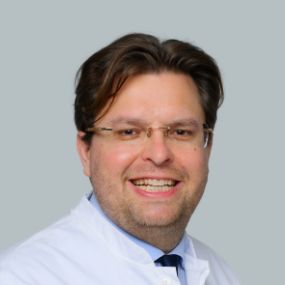The Centre for Ophthalmology of the University of Cologne is a national and international maximum ophthalmology care centre. The entire range of ophthalmology is represented at the highest standard within the Centre. We are available for our patients on 365 days of the year, around the clock.
The Ophthalmo-oncology and Ophthalmoplasty Centre cares for patients with tumours on and in the eye, as well as conditions of the eyelids, tear ducts, the surface of the eye and the orbital cavity.

Univ.-Prof. Dr. Dr. Ludwig Heindl
Specialist for Eyelid surgery, General ophthalmology in Cologne
Kerpener Strasse 6250924 Cologne
+49 221 46704136
(Landline at local rates)

+49 221 46704136
(Landline at local rates)
Special Clinical Focus
- Surgery to the eyelid (medical & aesthetic)
- Laser eyelid correction
- Surgery to the tear duct
- Tumour surgery on and in the eye
- Surgery to the orbital cavity
- Congenital and acquired conditions of the eyelids, tear-ducts & orbital cavity
Medical spectrum
Diseases
- Allergic conjunctivitis
- Blepharitis
- Cancer of the eye
- Cataract
- Cataract
- Chalazion / sty
- Conjunctival inflammation
- Corneal conditions
- Defective vision
- Diabetic retinopathy
- Diseases of the eye lens
- Ectropion
- Entropion
- Epiretinal gliosis
- Farsightedness
- Glaucoma
- Inflammation of the eye
- Macular degeneration
- Myopia
- Nystagmus
- Optic nerve disorders
- Presbyopia
- Protrusion of the cornea (keratoconus)
- Pterygium conjunctiva
- Ptosis
- Retinal Detachment
- Retinal diseases
- Strabismus
- Vitreous body detachment
- Vitreous body disorder
- Vitreous body opacification
Therapies
Diagnostic Services
- Standardised visual acuity testing
- Intraocular pressure measurement: using established and innovative techniques for the evaluation of the intraocular pressure: PASCAL® tonometer, rebound tonometer (iCare®), Goldmann tonometer, Perkins tonometer, Schiotz tonometer
- Visual field examination: static perimetry (Octopus), kinetic perimetry (Goldmann)
- Ultrasound (standardised A and B image echography): for precise measurement of tumours of the inside of the eye and the orbital cavity
- Ultrasound biomicroscopy (UBM): for precise measurement of tumours of the anterior segment of the eye, in particular, the iris and the ciliary body
- Colour vision testing for documentation of deficiencies in the visual field, such as for tumours of the orbital cavity or endocrine orbitopathy
- Biomorphometry of the optic papilla by means of spectral-domain optical coherence tomography (OCT) and Heidelberg retina tomography (HRT 3)
- Electrophysiology
- Tear film diagnostics: e.g. using Schirmer’s test I and II, break-up time for diagnosis for dry eye
- Tear duct diagnostics: tear duct irrigation, tear duct endoscopy
- Morphometry of the surface of the eye: corneal thickness measurement (pachymetry); corneal topography: for measurement of the anterior and posterior corneal surface; wave-front analysis of the cornea for examination of aberrations (image errors); Scheimpflug camera: for diagnosis of the anterior segment of the eye
- Biometry: measurement of the eye using the IOL Master (corneal radii, anterior chamber depth, bulbar length) or ultrasound A image
- Anterior segment OCT (optical coherence tomography) for high-definition non-invasive tissue examination of the anterior segment of the eye
- Photographic documentation of the eye lids, the surface of the eye, the iris, the retina and the choroid, and for precise monitoring of the progression in size
- Swab-examination: for diagnosis of infectious conditions of the conjunctiva and the cornea
- Histology: histopathological and immunohistochemical investigation of surgery slides
- State-of-the-art molecular genetics (monosomy-3 analysis, Next Generation Sequencing, Sanger Sequencing, etc.) of tumours of the eye
- Interdisciplinary care of tumour patients (screening, follow-up care, psycho-oncology care)
- Radiotherapy of tumours of the eye (ruthenium 106 brachytherapy, CyberKnife therapy)
Therapeutic Services
- Medical eyelid surgery for eyelid deformities, e.g. ectropion, entropion or ptosis
- Aesthetic eyelid surgery, e.g. for blepharochalasis
- Tumours of the eyelid such as basal cell carcinoma, melanoma
- Surgery to the tear ducts for watery eye due to tear duct stenosis
- Surgery to the orbital cavity for e.g. endocrine orbitopathy or tumours of the orbital cavity such as lymphomata or haemangiomata
- Tumours of the conjunctiva, iris, ciliary body, choroid
- Radiotherapy to tumours of the eye (ruthenium 106 brachytherapy, CyberKnife therapy)
Special Offers / Arrangements / Rooms
Interpreters and on-site care for our international patients
Directions
Plus Code: 9F28WWF8+CQ
University Hospital, Cologne
Kerpener Strasse 62
50924 Cologne
Webseite: augenklinik.uk-koeln.de
Call now: +49 221 46704136
Landline at local rates
